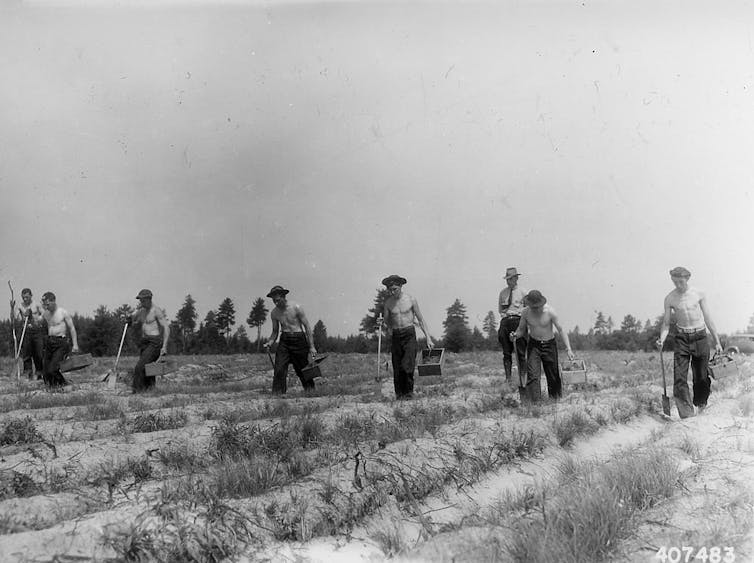The value of trees: 4 essential reads
- Written by Jennifer Weeks, Environment + Energy Editor, The Conversation
Trees are leafing out across much of the United States, providing a welcome transition from winter to spring. It’s easy to take this annual process for granted, but scholarship shows that trees provide all kinds of value. And we certainly miss them when they’re gone. Here are four expert takes on ways in which trees enrich our lives.
1. Cooling and greening city streets
Trees weren’t always part of urban landscapes. The first major tree-planting campaign in the U.S. launched in New York City in the 1870s, led by physician Stephen Smith, who believed that planting trees could save lives by providing shade during heat waves.
It took several decades to win support from the state legislature, but other wealthy New Yorkers joined the cause. In 1897 they started forming committees to plant trees in front of homes, tenement blocks and public schools.
“For these early activists planting trees was a way to cool streets and buildings in the summer[1] and beautify the city’s gritty urban landscape,” observes Harvard University landscape architecture professor Sonja Dümpelmann.
“Only later would scientists come to realize the enormous potential that urban trees besides entire forests held in mitigating the effects of climate change.”
2. Holding down the Great Plains
Planting trees was so central to the mission of the Civilian Conservation Corps during the 1930s that this New Deal agency was nicknamed “Roosevelt’s Tree Army.” The CCC was designed to put young men to work during the Great Depression on tasks that President Franklin Roosevelt stated would be “of definite, practical value.”
With dust storms ravaging the Great Plains, soil conservation was one such mission. CCC members planted some 3 billion trees in U.S. national forests and a “shelter belt” that stretched from North Dakota south to Texas, holding vulnerable soil in place. They also reseeded U.S. national forests across the country.
Benjamin Alexander, a historian at the City University of New York, sees the CCC as a predecessor of the modern conservation movement[2]:
“Although it is hard to picture a CCC-style initiative winning political support today, some of its ideas still resonate. Notably, the Obama administration’s economic stimulus plan and some proposals for upgrading U.S. infrastructure present federal spending on projects that benefit society as a legitimate way to stimulate economic growth. The CCC combined that strategy with the idea that America’s natural resources should be protected so that everyone could enjoy them.”
 Civilian Conservation Corps members planting red pine seedlings in upper Michigan’s Hiawatha National Forest.
USFS[3]
Civilian Conservation Corps members planting red pine seedlings in upper Michigan’s Hiawatha National Forest.
USFS[3]
3. Improving urban air and water quality
Today many city planners see trees as valuable investments. Theodore Endreny, a professor of engineering at the State University of New York’s College of Environmental Science and Forestry, wanted to put a dollar figure on that value, so he and his research team calculated it.
“Trees clean the air and water, reduce stormwater floods, improve building energy use and mitigate climate change, among other things,” Endreny writes. “For every dollar invested in planting, cities see an average US$2.25 return on their investment each year[4].”
The group developed a free software package called i-Tree Tools[5] that can estimate how trees will help to mitigate flooding, air pollution, building energy use and carbon dioxide emissions in a specific community. They found that trees provide especially large benefits in megacities like Beijing, Cairo and Mexico City, each of which house more than 10 million people. And all of these cities, even the leafiest of them, had the potential to add more trees.
Trees are an often-overlooked resource for fighting urban air pollution.4. Making streets safer
On a typical city street, trees are planted in small pits in the sidewalk, mainly for decoration and shade. Anne Lusk, a research scientist at the Harvard T.H. Chan School of Public Health, believes that they can do much more as part of smartly designed transportation networks with separate paths for cars and bikes.
In a survey of Boston pedestrians and cyclists, Lusk and her colleagues found that people strongly preferred streets where rows of trees or bushes separated sidewalks and cycle tracks from the street. Respondents said this configuration would make them feel safer, cooler and less exposed to pollution from cars.
Such designs, Lusk believes, should also be optimized to keep urban trees healthy. She recommends planting trees in continuous earth strips so that their roots could trade nutrients, and redesigning drainage system to channel water to tree roots.
In Lusk’s view, urban streets have prioritized cars over all other types of transit. “It is time to put equal effort into designing green streets for bicyclists, pedestrians, bus riders and residents[6] who live on transit routes, as well as for drivers,” she writes. Trees, she argues, should be an integral part of reimagining urban transport.
This article is a round-up of stories from The Conversation’s archive.
References
- ^ a way to cool streets and buildings in the summer (theconversation.com)
- ^ a predecessor of the modern conservation movement (theconversation.com)
- ^ USFS (commons.wikimedia.org)
- ^ an average US$2.25 return on their investment each year (theconversation.com)
- ^ i-Tree Tools (www.itreetools.org)
- ^ designing green streets for bicyclists, pedestrians, bus riders and residents (theconversation.com)
Authors: Jennifer Weeks, Environment + Energy Editor, The Conversation
Read more http://theconversation.com/the-value-of-trees-4-essential-reads-116047

